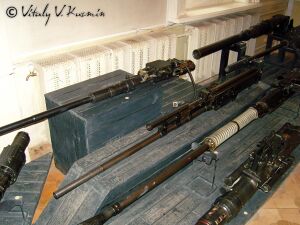Engineering:Berezin B-20
| B-20 | |
|---|---|
 Second from the top in the middle | |
| Type | Autocannon |
| Place of origin | USSR |
| Service history | |
| In service | Soviet Air Forces , Soviet Air Defence Forces |
| Wars | World War II, Korean War |
| Production history | |
| Designer | Mikhail Yevgenyevich Berezin |
| Designed | 1944 |
| Specifications | |
| Mass | 25 kg (55 lb) |
| Cartridge | 20×99mm |
| Calibre | 20 mm (0.8 in) |
| Barrels | 1 |
| Action | Gas |
| Rate of fire | 800 rounds/min |
| Muzzle velocity | 750–770 m/s (2,500–2,500 ft/s) |
The Berezin B-20 (Березин Б-20) was a 20 mm caliber autocannon used by Soviet aircraft in World War II.
Development
The B-20 was created by Mikhail Yevgenyevich Berezin in 1944 by converting his 12.7 mm Berezin UB machine gun to use the 20 mm rounds used by the ShVAK cannon. No other changes were made to the weapon which was pneumatically or mechanically charged and was available in both synchronized and unsynchronized versions. In 1946, an electrically-fired version was created for the turrets of the Tupolev Tu-4 bomber until the Nudelman-Rikhter NR-23 cannon became available. The B-20 was a welcome replacement for the ShVAK because it was significantly lighter - 25 kg (55 lb) to the 40 kg (80 lb) ShVAK - without sacrificing rate of fire or muzzle velocity.
Specifications
- Ammunition: 20×99mm
- Empty weight: 25 kg (55 lb)
- Muzzle velocity: 750–770 m/s (2,460-2,525 ft/s)
- Rate of fire: 800 rounds/min
- Mass of one-second burst: 0.95 kg (2.1 lb)
Production
The Soviet archives register the following production numbers by year:[1]
- 1944 — 2,275
- 1945 — 7,240
- 1946 — 440
- 1947 — 780
- 1948 — 1,686
- 1949 — 2,931
See also
- List of Russian weaponry
Related developments:
- Berezin UB machine gun
Similar weapons:
- ShVAK cannon
- MG FF cannon
- MG 151 cannon
- Ho-5 cannon
- Hispano HS.404 cannon
Notes
- ↑ Shirokograd, p 119
References
- Широкоград А.Б. (2001) История авиационного вооружения Харвест (Shirokograd A.B. (2001) Istorya aviatsionnogo vooruzhenia Harvest. ISBN:985-433-695-6) (History of aircraft armament)
- Koll, Christian (2009). Soviet Cannon - A Comprehensive Study of Soviet Arms and Ammunition in Calibres 12.7mm to 57mm. Austria: Koll. p. 121. ISBN 978-3-200-01445-9. http://www.russianammo.org.

